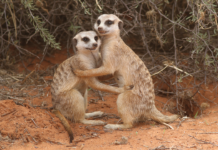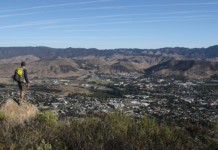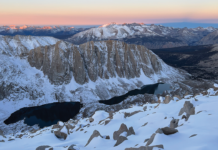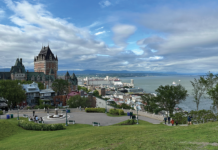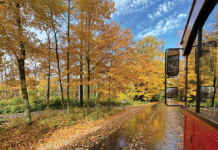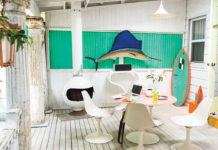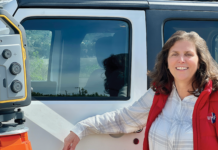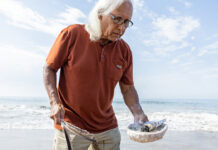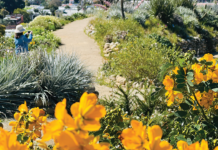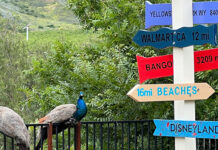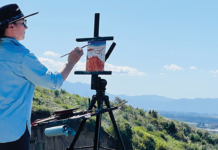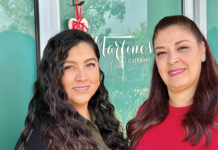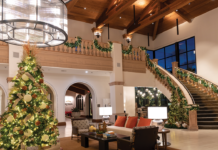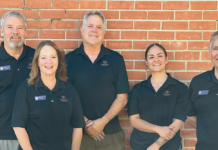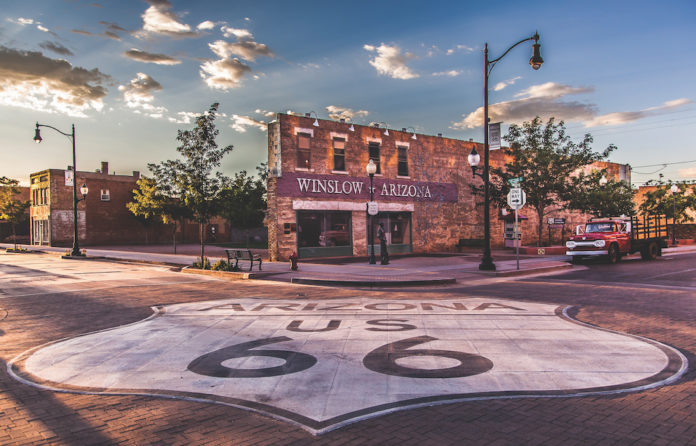TAKIN’ IT EASY A colorful sky enhances the wide-open-spaces ambience at Standin’ On The Corner Park in Winslow, Arizona. Photo courtesy Winslow Visitor Center/Chamber of Commerce
By Mike Nelson
How many records that reached No. 12 on the Billboard Hot 100 — and no higher — are celebrated with their own commemorative street corner?
And how many of them have inspired a renewed appreciation for what that corner, the town in whose heart it rests, and the desert beyond have to offer?
The list starts and ends with “Take It Easy,” the first of many hit records for folk rock band the Eagles. That song entered the Hot 100 on June 3, 1972 at No. 79, peaked at No. 12 on July 22, and by August 19 had left the Top 40.
But the Glenn Frey-Jackson Browne-penned tune about a guy trying to find his way through love and the desert has hardly left the hearts, minds and vistas of those who live in and visit Winslow, Arizona. For in the heart of this town of 9,000 along Route 66 in the northeast corner of the Grand Canyon State, a three-hour drive from Phoenix, is a monument celebrating the iconic second verse of “Take It Easy,” a lyric that has helped ignite tourism in Winslow and all of Northern Arizona.
Yes, “a-standin’ on a corner in Winslow, Arizona” is a life-sized bronze statue of a young man holding a guitar. Behind him is a trompe-l’oeil mural (courtesy of artist John Pugh) featuring “a girl, my Lord, in a flatbed Ford, slowin’ down to take a look at me.” Just like that unnamed woman, everyone else is taking a look at “Easy” — as the statue by sculptor Ron Adamson is named — on the corner of Second Street and North Kinsley Avenue aka The Corner.
Erected in 1999, the statue (which bears some resemblance to Browne) was joined in 2016 by a bronze rendering of Eagles’ co-founder Frey, who died earlier that year. The corner, the statues and the mural are visited annually by thousands of travelers (Eagles’ fans and others), and many return in late September when Winslow hosts an annual “Standin’ on the Corner” weekend music festival.
And many more, throughout the year, venture beyond Winslow to explore and enjoy natural wonders and recreational opportunities within an hour’s drive or two of the town…not least of which is the Grand Canyon itself, 130 miles west. Indeed, the “Standin’ on the Corner” monument has become an engine of economic renewal that has helped return Winslow to a place of prominence and privilege.
Celebrity Hangout
Until the 1960s, Winslow was not only a fine sight to see but a fine place to stay for celebrities traveling by rail or driving along Route 66. Among the famous was Charles Lindbergh, who stayed in Winslow during construction of the Winslow-Lindbergh Regional Airport (still in use), and the Shah of Iran, who landed at Winslow in 1949 so he and his entourage could later visit the Grand Canyon.
The favorite hangout for many was the La Posada Hotel, originally built in 1929 alongside the Santa Fe Railroad line by the Fred Harvey Company and considered to be the last of the great trackside hotels. From the 1930s to the 1950s, La Posada was visited and inhabited by golden age movie stars (Clark Gable, Carole Lombard, Jimmy Stewart), cowboys (Gene Autry, Hopalong Cassidy, Will Rogers), presidents (FDR, Harry Truman), scientists (Albert Einstein) and moguls (Howard Hughes).
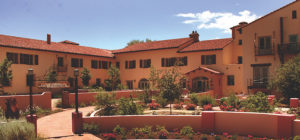
But as rail travel became secondary to auto and air transport, the popularity of “glamour” lodgings like La Posada subsided. The hotel closed in 1957 and, though spared demolition several times, fell into serious disrepair.
Even more damaging was the creation of Interstate 40, running from North Carolina to Barstow, replacing Route 66 as the main east-west highway through the southern U.S., and bypassing Winslow. The town’s economy suffered, with mom-and-pop stores replaced by large national chain operations, and its population dropped from nearly 9,000 in 1960 to less than 8,000 in 1980, by which time the Eagles were well established as America’s leading rock band.
Glory restored
It wasn’t until the 1990s that 14 local, revitalization-minded volunteers decided to establish what would become the “Standin’ On the Corner” Foundation and solicited submissions for artwork to commemorate Winslow’s place in American rocklore.
On Sept. 10, 1999, Ron Adamson’s statue and John Pugh’s mural (with an eagle perched outside a window, above the girl in the Ford) were dedicated, later joined by Frey’s likeness. Two decades later, tourists and tourist dollars have flowed into Winslow and Navajo County at record levels, peaking at $355 million in 2019 or 35 percent above 2011, according to the Arizona Office of Tourism. (Even with a pandemic-influenced drop in 2020, spending was still 19 percent above 2011.)
Some of them choose to stay at the La Posada Hotel, once the jewel in the design crown of Mary Jane Colter, chief architect for the Fred Harvey Company, whose stylish hotels and restaurants graced hundreds of miles of the Santa Fe Railway in the mid-20th century. Thanks to the husband-wife team of Allen Affeldt and Tina Mion, La Posada was not simply rescued from demolition, but lovingly restored to its original glory, and then some.
Historic elegance and modern comfort abound in La Posada’s southwestern-decorated rooms and 12 acres of serene gardens. The works of Tina Mion, one of Winslow’s most famed contemporary painters, and other area artists are regularly featured in the hotel and several nearby exhibit spaces operated by the Winslow Arts Trust.
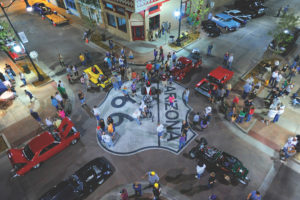
Photo courtesy Winslow Visitor Center/Chamber of Commerce
Out and About
Conveniently situated a few blocks from “The Corner” and 100 feet from Winslow’s Amtrak Station (where the Southwest Chief stops on runs between L.A. and Chicago), La Posada is but one of nearly a dozen lodgings in Winslow. They provide excellent bases not only for visitors to “loosen” their loads, but branch out in all directions to visit any or all of Northeast Arizona’s scenic delights which, collectively, speak to interests ranging from cultural and historical to geological and environmental.
Following are but a few fine sights — any one of them a good “place to make your stand” — in, near and within half-a-day’s driving of Winslow.
IN WINSLOW
• Standin’ on the Corner Park (downtown, East Second Street and North Kinsley Avenue)
The intersection of this “pocket park” is inlaid with a huge Route 66 Shield that reminds folks that they are on “the Mother Road.” The chief draw is the aforementioned statuary and mural — not to mention the posing tourist. But in a six-block radius surrounding the park are restaurants, a brewery, gift shops, galleries and more. The annual music festival takes place this year Sept. 23-24, 2022. For more information, call 480.326.3486 or visit www.standinonthecorner.org.
• Church of the Mother Road (downtown, 116 East Second Street)
A half-block east of Standin’ on the Corner Park, behind the wrought iron gates of Skylark Courtyard, is the smallest church on Route 66, and maybe anywhere else. Built as a memorial for those who lost their lives in Vietnam, it serves as a fine place for prayer, rest and meditation.
• Old Trails Museum/Winslow Historical Society (Downtown, 212 North Kinsley Avenue)
In the heart of Winslow’s historic district, it houses ancient Native American artifacts, Santa Fe Railroad equipment, Fred Harvey and Route 66 memorabilia, and more. 928.289.5861, oldtrailsmuseum.org.
• 9-11 Remembrance Garden (East end of town, East Third Street and Transcon Lane, off I-40)
The centerpiece of the garden (and adjacent to Winslow’s Dog Park and Community Garden) is a pair of 14- and 15-foot steel girders from the World Trade Center, the largest pieces given to any community in the nation. Every Sept. 11, Winslow hosts a memorial service and recognition event to acknowledge and celebrate the bravery and sacrifices made by police and firefighters.
NEAR WINSLOW:
• McHood Park and Clear Creek Reservoir (6 miles southeast of downtown)
Swimming, fishing, hiking, picnicking, camping and canoeing (rentals available) are among the outdoor activities available at this tidy resting and “cool down” spot, enjoyed by locals for more than 100 years. 928.289.4792, www.go-arizona.com/McHood-Park-Campground.
• Homolovi State Park (3 miles northeast)
The park/campground offers ancient ruins of pueblos that were built 700-900 years ago by ancestors of the Hopi tribe as well as colorful pottery, shards and ancient petroglyphs. 928.289.4106, azstateparks.com/homolovi/.
• Little Painted Desert County Park (18 miles northeast)
An exotic combination of colors and natural rock formations, hiking trails and tables makes this a place to, yes, take it easy with a sunset picnic dinner. www.outdoorproject.com/united-states/arizona/little-painted-desert
• Rock Art Ranch (23 miles southeast)
It’s not a celebration of music makers, but rather a working cattle ranch (reservations required) which offers an exemplary display of Anasazi petroglyphs as well as sweeping vistas of the San Francisco Peaks and the volcanic buttes of the Navajo Reservation. 928.288.3260, www.atlasobscura.com/places/rock-art-ranch.
• Meteor Crater and Barringer Space Museum (26 miles west)
Earth’s best-preserved impact site features topographical terrain that closely resembles the surface of the moon — one reason NASA designated the crater as the training site for all U.S. astronauts. Camping is available. 928.289.5898, meteorcrater.com.
FURTHER OUT:
• Painted Desert and Petrified Forest National Park (60 miles
east/northeast)
“El Desierto Pintado,” so named by explorer Francisco Vasquez de Coronado in 1540, actually begins at the east end of the Grand Canyon and stretches 150 miles into the Petrified Forest. Although much of the desert is in remote areas of the Navajo Nation, it is still accessible enough for visitors to admire its sweeping vistas of “moonscape mounds” formed of purple, red and gray segments. The forest is a geologic treasure chest of trees that have turned to stone, fossilized bones of 200 million-year-old animals, and abundant Indian ruins and petroglyphs. Warning: removal of natural objects can lead to fines, jail time or both. 928.524.6228, www.nps.gov/pefo/.
• Holbrook (32 miles southeast)
A one-time gunslingers’ and cattle rustlers’ town deemed “too tough for women and churches,” Navajo County’s seat (pop. 5,000) boasts, of course, Bucket of Blood Street and the same-named Saloon (now a boarded-up warehouse), as well as one of the few historic Wigwam Motels still in existence. 928.524.6225, www.holbrookaz.gov.
• Walnut Canyon National Monument (50 miles west)
More than 300 small cliff dwellings, sheltered in caves, were home to native inhabitants more than 800 years ago who farmed, hunted, gathered and traded. The ruins still stand, protected against the elements, and are joined by a visitor center, hiking trails and picnic area. 928.526.3367, www.nps.gov/waca/.
• Canyon de Chelly National Monument, Chinle (130 miles northeast)
At the base of sheer red cliffs and in canyon wall caves are ruins of Indigenous villages built between 350 and 1300 on this land where the Navajo continue to live and farm today. 928.674.5500, www.nps.gov/cach/index.htm.
AND THE GRAND DADDY OF THEM ALL….
• The Grand Canyon (130 miles west)
It borders on sacrilege, probably, for an Arizona travel story not to include this finest of all natural sights to see, long ago carved out of the desert by 277 miles of the Colorado River and shaped over millions of years. It is open for visitors, lodging and camping, but consult the regularly updated website for updates and possible closures. 928.638.7888, www.nps.gov/grca.


